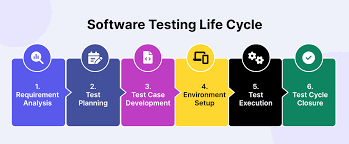Breaking Down the Basics: An Introductory Guide to Software Testing

Strong 8k brings an ultra-HD IPTV experience to your living room and your pocket.
Software testing is a vital component of the software development lifecycle (SDLC). It ensures that software meets the required standards for quality, functionality, and performance before being delivered to end-users.
Understanding Software Testing
Software testing involves evaluating and verifying that a software application or system functions as intended. This process includes running the software under controlled conditions to identify defects, bugs, or any issues. The primary objective of software testing is to ensure the software is reliable, secure, and performs as per the specified requirements.
Why is Software Testing Important?
The importance of software testing lies in several key aspects:
Quality Assurance: Testing helps in identifying and fixing bugs before the software is released, ensuring a high-quality product.
Cost Efficiency: Detecting defects early in the development process is more cost-effective than fixing them later.
Security: Testing identifies vulnerabilities that could be exploited by malicious users, ensuring the software’s security.
User Satisfaction: Delivering a reliable, bug-free product increases user satisfaction and trust in the software.
The Software Testing Lifecycle (STLC)
The Software Testing Lifecycle (STLC) comprises a series of activities that ensure the quality of the software.
The key stages include:
Requirement Analysis: Testers review the software requirements to determine what needs to be tested. This stage is critical for defining the scope and objectives of testing.
Test Planning: A detailed test plan is created based on the requirements. This plan includes selecting tools, defining roles and responsibilities, estimating effort, and scheduling testing activities.
Test Case Development: Specific test cases and scripts are developed in this phase, covering both positive and negative scenarios.
Test Environment Setup: The testing environment is set up to replicate the production environment, including necessary hardware, software, and network configurations.
Test Execution: Test cases are executed to evaluate the software. Any defects or issues are logged for further analysis.
Defect Reporting and Tracking: Identified defects are reported and tracked until they are resolved. Testers collaborate with developers to ensure all issues are addressed.
Test Closure: After all tests have been executed and defects resolved, the testing process is formally closed. A final report is prepared, documenting the testing process, results, and lessons learned.
Types of Software Testing
Software testing can be broadly divided into two categories: Manual Testing and Automated Testing. Each serves different purposes in the testing process.
Manual Testing
In manual testing, testers execute test cases manually without automated tools. Although time-consuming, manual testing is crucial for tasks requiring human intuition, such as:
Exploratory Testing: Testers explore the software without predefined test cases to identify potential issues.
Usability Testing: Ensures that the software is user-friendly and intuitive.
Ad-hoc Testing: Performed without planning or documentation, often used for quickly validating a specific function.
Automated Testing
Automated testing uses tools and scripts to execute test cases automatically, making it ideal for repetitive tasks and large projects.
Common types include:
Unit Testing: Tests individual components or functions of the software in isolation.
Regression Testing: Ensures that new changes do not negatively affect existing functionality.
Performance Testing: Measures software performance under various conditions, including load and stress testing.
CI/CD Testing: Automated tests are integrated into the Continuous Integration/Continuous Deployment pipeline to provide rapid feedback on code changes.
Software Testing Methodologies
Different methodologies guide the software testing process, depending on the project’s requirements and development approach.
Common methodologies include:
1. Waterfall Methodology
The Waterfall methodology follows a linear, sequential approach to software development, where testing occurs after the development phase. While straightforward, it can be inflexible, making it challenging to address changes once a phase is completed.
2. Agile Methodology
Agile is an iterative and incremental methodology where testing is integrated throughout the development process. Agile emphasizes collaboration, flexibility, and customer feedback, with testing being continuous in short cycles called sprints.
3. DevOps Methodology
DevOps is a cultural and operational shift that unifies development and operations teams to enhance the software delivery process. Testing is automated and integrated into the CI/CD pipeline, ensuring frequent and reliable software releases.
4. V-Model
The V-Model, or Verification and Validation model, is an extension of the Waterfall methodology. It pairs each development stage with a corresponding testing phase, emphasizing the importance of testing at every development stage.
Best Practices in Software Testing
To ensure effective software testing, adhere to these best practices:
Early Testing: Begin testing as early as possible in the development process to identify and resolve defects before they become complex and costly.
Test Automation: Automate repetitive and time-consuming tasks to increase efficiency and reduce human error.
Clear Requirements: Ensure that software requirements are well-defined and documented, as unclear requirements can lead to inadequate testing.
Comprehensive Test Coverage: Cover all possible scenarios, including edge cases and negative tests, to ensure the software performs well under all conditions.
Regular Communication: Maintain open communication among testers, developers, and stakeholders to align on testing objectives and progress.
Continuous Improvement: Regularly review and refine testing processes to adapt to changing project needs and incorporate lessons learned.
Common Challenges in Software Testing
Software testing comes with its own set of challenges, including:
Time Constraints: Tight deadlines can lead to shortcuts and missed defects.
Complexity: As software systems become more complex, achieving comprehensive test coverage becomes more challenging.
Changing Requirements: Frequent changes can lead to scope creep, making it difficult to plan and execute tests effectively.
Resource Limitations: Limited resources, such as testing tools and skilled personnel, can impact the quality of testing.
Bias: Testers may develop biases towards the software, assuming certain functions work correctly without thorough testing.
Tools and Technologies in Software Testing
A variety of tools support the software testing process, ranging from test management software to automated testing frameworks.
Popular tools include:
Selenium: An open-source tool for automating web browsers, widely used for functional and regression testing.
JIRA: A project management tool that also supports test case management and defect tracking.
Apache JMeter: A performance testing tool for assessing web application performance under different conditions.
TestNG: A testing framework inspired by JUnit, designed for Java applications.
Cucumber: A tool supporting Behavior-Driven Development (BDD), allowing tests to be written in plain language.
Future Trends in Software Testing
Software testing is continually evolving, with new trends and technologies shaping the field. Emerging trends include:
Artificial Intelligence and Machine Learning: AI and ML are increasingly used in testing tools to predict defects, optimize test cases, and enhance automation.
Shift-Left Testing: Testing is moving earlier in the development process, focusing on early defect detection and prevention.
Continuous Testing: In CI/CD pipelines, continuous testing ensures that software is validated at every stage of development, enabling faster and more reliable releases.
IoT Testing: As the Internet of Things (IoT) expands, testing for IoT devices and systems is becoming increasingly important for ensuring interoperability and security.
Test Data Management: Effectively managing test data is becoming critical, especially in environments with strict data privacy regulations.
Conclusion
Software testing is an integral part of the software development process, ensuring that the final product is of high quality, meets user expectations, and is free from critical defects. To develop the skills needed to excel in this field, many professionals seek out the best software testing course in Thane, Mumbai, Navi Mumbai, Delhi, Noida, and other cities across India. These courses provide in-depth knowledge of testing types, methodologies, and best practices, equipping learners with the tools to contribute to the creation of reliable and robust software applications. As the industry continues to evolve, staying up-to-date with the latest trends and technologies, through continuous learning and practical experience, will be essential for maintaining effective testing practices.
Note: IndiBlogHub features both user-submitted and editorial content. We do not verify third-party contributions. Read our Disclaimer and Privacy Policyfor details.


